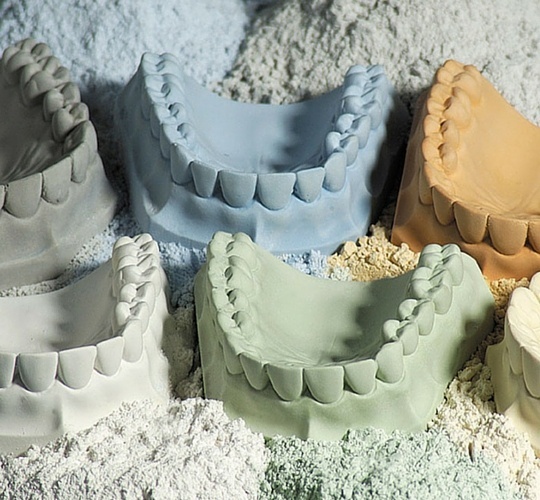Most dental gypsums begin their life as Calcium Sulfate Dihydrate (CaSO4 . 2H2O), mined from the ground in specific areas throughout the world. Through a heating and crushing process, it becomes Calcium Sulfate Hemihydrate (CaSO4 . 1/2H2O) due to a loss of water in the process. With unique additives and colorants, we develop the dental stones we use daily in the lab and dental office.
With the primary component in all dental stone being gypsum, there are few thing to be aware of when storing these materials. The main thing is that the powder is trying to absorb water from any source possible, including humidity in the air. It is trying to get that water back and get to the natural state of when it was mined. When we add the correct water / powder ratio, we are returning the gypsum to that natural state, usually in the form of a dental cast. There is also another consideration - contamination with other gypsum products or worse yet, phosphate powders such as investment. To avoid this, keep the gypsum in the original bag and scoop it out as needed with a dedicated clean scoop. Closing the bag after each use is a good first step in keeping moisture out of the stone.
You may want to put the gypsum in a drawer or container of some sort, since the large boxes it comes in can be a bit bulky and take up too much space. Instead of taking the stone out of the bag and dumping it into the container, why not just remove the bag and place that in the container of choice? The benefit is you have taken the cumbersome box out of the equation, while still having the ability to seal the bag and maintain the integrity of the gypsum. Although it still might be a good idea to cut the label off the box and put it in the storage container with the bag of stone. If there is any issue with the gypsum, the item number and lot number are needed to help analyze any problems.
If you want to be really on top of things, you may want to preweigh your material in individual bags to save time during the mixing and pouring process. The size can be tailored to meet your particular demands. All you need is a common digital kitchen scale and zip-lock bags. The main thing to remember is to zero out the scale (tare) to remove the bag weight before the powder is weighed. This little trick is a great way to speed up your process and not have the added expense of purchasing prepackaged envelopes. You can still buy in bulk, cutting costs and still achieve consistency with your mixes.









Leave a comment